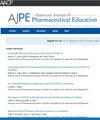2004 年至 2022 年药剂师就读药剂学校的可负担性。
IF 3.8
4区 教育学
Q1 EDUCATION, SCIENTIFIC DISCIPLINES
引用次数: 0
摘要
目的:评估 2004 年至 2022 年药学技术人员工资与药学院第一个专业学年(P1)学杂费的相对趋势,并评估目前受雇于药店的技术人员对药学教育的可负担性:这项观察性横断面研究利用美国劳工统计局的数据计算药学技术人员的可支配收入中位数,并利用美国药学院协会学费趋势数据库计算药学专业学生 P1 州内学费和强制学费的累计总和。主要结果是全国学费负担率的变化,即可支配收入中位数与 P1 学年学杂费总额中位数的比较。作为次要结果,分析了各州最负担得起的课程的学费负担率的变化:研究发现,从 2004 年到 2022 年,全国药学技术人员的可支配收入中位数从 20,103 美元增至 33,255 美元,而 P1 年学杂费中位数则从 13,223 美元增至 36,183 美元。学费负担能力比率中位数从 2004-05 学年的 1.52 降至 2022-23 学年的 0.92,表明负担能力下降了 40%。对各州的分析表明,各州的可负担比率各不相同,只有宾夕法尼亚州和罗德岛州的可负担比率有所上升:该研究强调了药学教育可负担性的显著下降,引起了人们对未来药学学生所面临的经济障碍的关注,并呼吁重新评估该领域的财务策略。本文章由计算机程序翻译,如有差异,请以英文原文为准。
Pharmacy School Affordability for Pharmacy Technicians From 2004 to 2022
Objective
This study aimed to evaluate the trends in pharmacy technician wages relative to pharmacy school tuition and fees for the first professional year (P1) from 2004 to 2022, and to assess the affordability of pharmacy education for those currently employed as technicians in a pharmacy.
Methods
This observational cross-sectional study used data from the United States Bureau of Labor Statistics to calculate median disposable incomes for pharmacy technicians and the American Association of Colleges of Pharmacy Tuition Trends Database to calculate cumulative sums of P1 in-state tuition and mandatory fees for pharmacy students. The primary outcome was the national change in the tuition affordability ratio, defined as the comparison of median disposable income with median total tuition and fees for P1. Changes in the tuition affordability ratio for the most affordable programs in each state were analyzed as a secondary outcome.
Results
The study found that from 2004 to 2022, the median disposable income of pharmacy technicians nationally increased from $20,103 to $33,255, while median P1 tuition and fees rose from $13,223 to $36,183. The median tuition affordability ratio decreased from 1.52 in the 2004–2005 academic year to 0.92 in 2022–2023, indicating a 40% reduction in affordability. State-specific analysis revealed varying affordability ratios, with only Pennsylvania and Rhode Island showing an increase in affordability.
Conclusion
The study highlights a significant decline in the affordability of pharmacy education, raising concerns about the economic barriers faced by prospective pharmacy students and calling for a reevaluation of financial strategies within the field.
求助全文
通过发布文献求助,成功后即可免费获取论文全文。
去求助
来源期刊
CiteScore
4.30
自引率
15.20%
发文量
114
期刊介绍:
The Journal accepts unsolicited manuscripts that have not been published and are not under consideration for publication elsewhere. The Journal only considers material related to pharmaceutical education for publication. Authors must prepare manuscripts to conform to the Journal style (Author Instructions). All manuscripts are subject to peer review and approval by the editor prior to acceptance for publication. Reviewers are assigned by the editor with the advice of the editorial board as needed. Manuscripts are submitted and processed online (Submit a Manuscript) using Editorial Manager, an online manuscript tracking system that facilitates communication between the editorial office, editor, associate editors, reviewers, and authors.
After a manuscript is accepted, it is scheduled for publication in an upcoming issue of the Journal. All manuscripts are formatted and copyedited, and returned to the author for review and approval of the changes. Approximately 2 weeks prior to publication, the author receives an electronic proof of the article for final review and approval. Authors are not assessed page charges for publication.

 求助内容:
求助内容: 应助结果提醒方式:
应助结果提醒方式:


